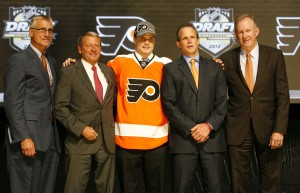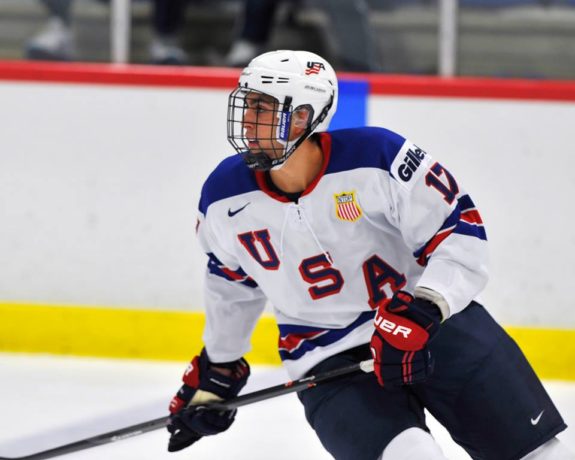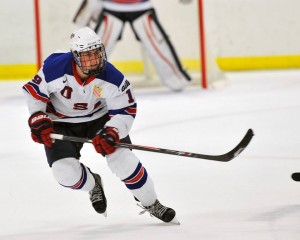Those have been the words uttered by many commentators and fans alike when mocking a player to the Flyers in the 2014 Draft. Sometimes, they have been a compliment, like when describing Scott Laughton or Samuel Morin, two physical youngsters that can actually play. Those have also been the words uttered when the Flyers have made the selections of players like Garrett Klotz, Derek Mathers, Zac Rinaldo, and more recently, Tyrell Goulbourne. In that tone, the comment is a borderline insult.

The Flyers draft brass has two big strengths, and two obvious weaknesses. Their strength lies in their ability to develop young forwards (mostly centers) into quality NHLers, and produce quality bottom 6 players. Their weaknesses are in drafting and developing defensemen, and goaltenders.
Their strengths have produced possibly the best center depth in the NHL, and great overall depth at forward. The weaknesses have produced a defense without a single homegrown player on it, and a quality goalie that was thought to be “finished” when he was acquired.
The Flyers have tried to address their weaknesses in the past two drafts. Anthony Stolarz is the best goaltending prospect the Flyers have had in years, and the trio of Gostisbehere, Morin, and Hagg offers the best potential for homegrown defensemen in some time. However, if the Flyers draft according to their old ways in 2014, it will be a big step back for the organization.
With the 17th overall pick, the Flyers will likely have their choice of a few players that represent a significant step forward for the organization, or a step back into their past.
Flyers Draft Goes Back to the Dark Ages
The prototypical Flyers draft pick is the big, gritty, physical forward. He’s a two-way player, and a leader in the locker room. However, rarely is he the best offensive player available. The Flyers pride themselves on having a number of power forwards on the team, specifically Scott Hartnell and Wayne Simmonds. They’re two valuable players to the team. But, they were also among the most over-matched when their skating problems were exposed by the fleet-of-foot Rangers. Craig Berube, himself, admitted the Flyers were outmatched in terms of speed:
Berube told the Daily News’ Frank Seravalli, “To try to beat him wide with speed, other than Voracek, [McDonagh is] probably going to win that battle a lot of times.”
Other than Voracek, the Flyers don’t have any burners among their forwards. It is good to have guys like Simmonds and Hartnell on the team, but the Flyers don’t need another gritty, puck-winning power forward. What they need is burners and high-skilled players on the wings to complement their elite centers.

In many of the 2014 Mock Drafts, the Flyers have been interested in USNTDP products Alex Tuch (here and here) and Dylan Larkin. I don’t have a problem with either player as a prospect, just as a potential pick for the Flyers.
Tuch is a 6’3″ right wing that played for the USNTDP, totaling 96 points across all games this year. Normally, scouts would be drooling over a player with Tuch’s size and that offense. However, the offense comes with a big asterisk. That’s because Tuch played on a line with Jack Eichel and Sonny Milano, two of the most talented players to come out of the US program in years. They outscored Tuch by 38 and 29 points, respectively, this year. Tuch does the grunt work for his linemates. Without them, you have to wonder what his numbers would look like.

Dylan Larkin is a jack of all trades, master of none. He’s a two-way center with good speed (which the Flyers lack), decent offense, and a power-forward game. He’s a lot like current Flyer prospect Scott Laughton.
Tuch doesn’t make sense because the Flyers already have two guys that do his job in Scott Hartnell and Wayne Simmonds. Larkin doesn’t make sense because he projects best as a center, where the Flyers have no room. They’re having trouble finding room for Scott Laughton, let alone another first round pick at center. You could move him to wing, but you’d be wasting his defensive abilities because a center has a much larger impact on the defensive side of the puck compared to a winger.
Besides not being a fit, the last few power forwards to come from the USNTDP have not fared well. One has been taken in the first round the past three years, and all three have struggled post-draft.
Tyler Biggs was the 22nd overall pick in the 2011 draft by the Maple Leafs. Since then, he’s played a year at Miami University, a year in the OHL, a year in the AHL, and had a trip to the WJC. He was average in the NCAA and OHL, a disappointment at the WJC, and played 56 games in the AHL last year, collecting just 9 points.
Stefan Matteau was the 29th overall pick in the 2012 draft by the New Jersey Devils. The year after being drafted, he played 17 NHL games and collected 3 points. He was returned to the QMJHL, where he put up 28 points in 35 games on a stacked Blainville-Boisbriand Armada team. But in the playoffs, he walked off the bench, with his dad as coach. This past year, he had an okay season in the AHL, with 26 points in 67 games.
At 6’6″, 238 lbs., Michael McCarron was the 25th overall pick in the 2013 draft. He opted to forgo playing college hockey at Western Michigan in favor of the London Knights. McCarron struggled throughout most of the year on a very good Knights team, putting up just 34 points in 66 games.
Just because three recent products have not been great does not mean Tuch and Larkin are doomed for failure. However, it’s something the Flyers draft brass should keep in the back of their mind.
Who Should the Flyers Pick?
For the Flyers draft class of 2014 to be a success, they need to continue to stockpile puck-moving, offensive defensemen, and gather speed/skill on the wings. Right now, Voracek is the only elite talent the Flyers have at wing. On defense, the Flyers are among the slowest teams in the league. Fortunately for Philadelphia, there will be a few players that should fill those needs very well around pick #17. An article and scouting report for those four will follow in the next day or two.